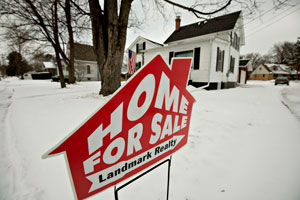Previously Owned Home Sales Increase to One-Year High

Purchases of previously owned U.S. homes unexpectedly rose in October to a one-year high as low borrowing costs helped sustain the recovery in residential real estate.
Existing homes sold at a 5.26 million annual pace, the strongest since September 2013 and up 1.5% from a revised 5.18 million pace in September, the National Association of Realtors reported Nov. 20 in Washington. It was the fifth consecutive month that the sales pace topped 5 million. Prices also climbed, the group said.
Employment growth and mortgage rates near historic lows are helping stir buying interest that will probably underpin the economy. At the same time, limited wage gains, student debt and stricter lending standards are headwinds for those looking to own for the first time.
“This is much healthier than we’ve seen over the last year or so,” said Scott Brown, chief economist at Raymond James & Associates in St. Petersburg, Florida, who projected a 5.25 million pace of sales. “We’re still a long way from recovery, but we’re on our way.”
The median forecast in a Bloomberg News survey of 78 economists called for a 5.15 million pace of resales, with estimates ranging from 5.05 million to 5.27 million. September’s figure was revised from a previously reported 5.17 million.
The NAR’s figures showed the median price of an existing home that was sold in October advanced 5.5% to $208,300 last month from a year earlier. Purchases increased 4.7% from a year earlier on an unadjusted basis.
Total inventories fell 2.6% to 2.22 million, which included a 3% decline in the supply of single-family homes, which stand at 1.96 million.
At the current pace, it would take 5.1 months to sell those houses, compared with 5.3 months at the end of September. A year ago, inventory stood at 1.86 million.
Single-family sales increased 1.3% to a rate of 4.63 million a year. Multifamily properties including condominiums sold at a 630,000 annual pace, up 3.3% from September.
Total sales improved in three of four regions last month, led by a 5.1% gain in the Midwest. Demand fell in the West.
Cash transactions accounted for about 27 % of all purchases in October, up from 24% a month earlier, the report showed.
Foreclosures and other distressed property sales accounted for 9 % of the total last month, little changed from 10% in September.
The share of properties sold to first-time buyers was 29 % in October. It’s been less than 30% in 18 of the last 19 months.
“I think first-time buyers this year are at the low point and I do anticipate growth going into next year,” NAR chief economist Lawrence Yun said at a news conference as the figures were released. There’s “more job creation and I think underwriting standards will be dialed down modestly.”
Sales of existing homes, tabulated when a purchase contract closes, are recovering from a 13-year low of 4.11 million in 2008. They remain well below the record 7.08 million in 2005.
Cheaper borrowing costs have helped underpin housing. The average 30-year, fixed-rate mortgage was 4.01% in the week Nov. 13, down from 4.35% a year ago, according to data from Freddie Mac in McLean, Virginia.
Borrowing costs held remained low as Federal Reserve policy makers keep their main interest rate near zero.
Minutes of the central bankers’ October meeting showed a wide-ranging debate over whether to retain a pledge to keep rates near zero for a “considerable time.”
The housing recovery is giving a lift to home-improvement retailers Home Depot Inc. and Lowe’s Cos., which are seeing more homeowners renovate their properties.
Lowe’s Chief Executive Officer Robert Niblock has added workers to help customers with projects, and the retailer’s decision to cater more to professional contractors has paid off. The Mooresville, North Carolina-based company raised its annual profit and sales forecast.
Atlanta-based Home Depot, the largest U.S. home-improvement chain, sees the benefits from the housing recovery persisting, Chief Financial Officer Carol Tome said.
“We continue to believe we will get help from housing,” Tome said on a Nov. 18 earnings call. “We’ll get help from home price appreciation, not as robust as it was last year, but it will continue to recover because it has not fully recovered.”

